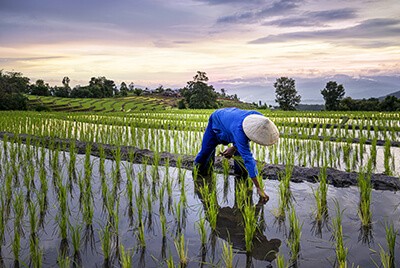Rice, Please – Hold The Methane

By Merry Morris
Rice presents a dilemma. On one hand, its starchy grains support nearly half the world’s population.
On the other hand, rice production goes hand-in-hand with methane generation. Rice paddies generate 17 percent of the world’s methane, the second most important greenhouse gas, at 100 million tons per year.
Fine-Tuning Rice Genes
Studying the ecosystem of rice plants (the sunlight, soils, water, nutrients, microorganisms, and more) reveals its complexity: photosynthesis to create rice sugars, cycling of nutrients, sugar transport throughout the plant’s grain, stem, leaves and roots; release of chemicals into the soil. The transport of sugars throughout the plant’s rich, starchy rice grains and hardy leaves and stems is all for the good. The rice grains provide sustenance, and the leaves and stems are used as biofeedstocks.
It’s at the roots where the methane issues arise. The rice plant roots leak nutrients into their surroundings. The root’s leakage or exudates support microorganisms, some of which are methanogens, or generators of methane. More rice production means more methane…unless something could be changed at the root level.
Looking Deep Into The Cells For An Answer
Christer Janssen and his fellow researchers found that certain proteins called transcription factors could bind to plant genes and turn them on or off. Researchers realized if they could isolate the transcription factors that controlled the genes for transporting rice sugars, they could manipulate where transcription factors were produced and carbon stored. For rice, that would affect where sugars were stored in the rice plant. Perhaps reducing the amount of sugar accumulating in the rice plant roots would reduce the nutrient leakage into the soil.
Finding the right transcription factor to solve the methane-emission problem was not an easy feat. Using a highstarch- producing barley, researchers focused on the most active genes in the grains. Once these were isolated, the search began for the right transcription factors. Investigators found SUSIBA2 (SUgar Signaling in BArley 2) to be a “master regulator” factor that could control several genes.
If introduced into a rice strain, could SUSIBA2 reduce the sugars going to the roots, “starving” the roots and thereby reducing methane-supporting nutrient leakage from the roots? Would diverting the carbon from the roots enable more food energy to be used for grains, stems and leaves? Results from a recently completed three-year field test have confirmed that SUSIBA2 bearing rice did virtually eliminate methane emissions, while increasing crop yields. Success is at hand.
Research continues; however, including investigating the potential effects of changing the methane-generating populations in the soil.
Extension Questions
- Why is methane called a “greenhouse” gas? What chemical reactions does it undergo in global warming?
- What is microbial ecology? How does it help us understand more about relationships among microorganisms?
- Methane-producing microorganisms are called methanogenic archaea. How are archaea different from bacteria?
